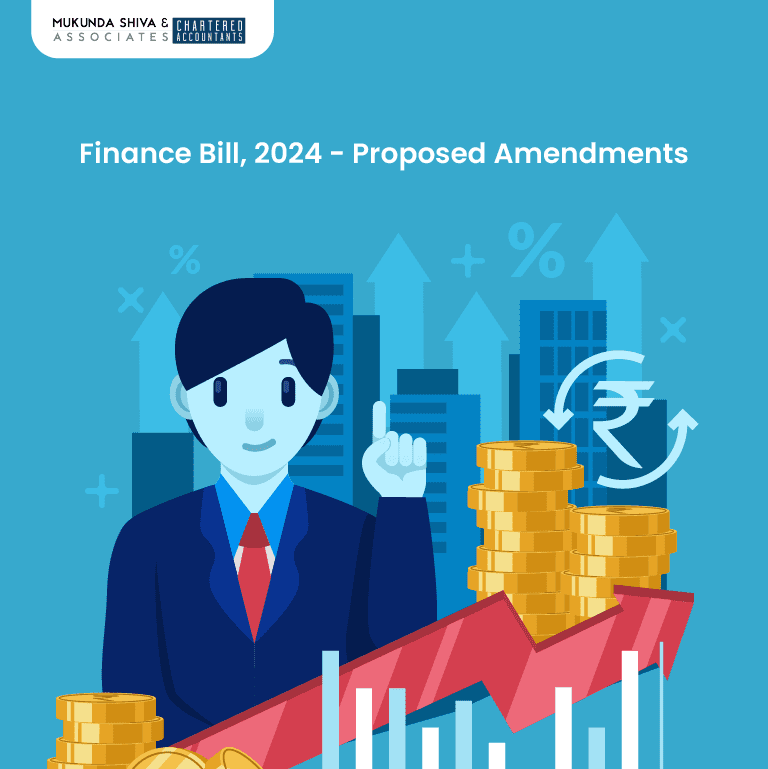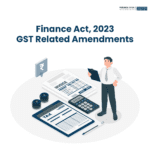
Finance Bill, 2024 - Proposed Amendments
Summary of Amendments – DIRECT TAXATION
During today’s pre-election budget proposed for the financial year 2024-25, it is to be noted that there are no significant amendments. Few changes introduced under the taxation laws are highlighted below for your reference –
A. Goods and Services Tax :
1. The definition of input service distributor is amended allowing such ISDs to receive input services liable under reverse charge.
2. The mechanism of distribution of credits by ISD is amended with the intention to make ISD registration compulsory for all entities having more than 1 registration under the same PAN. The rules for executing this amendment is yet to be notified. However, it may be necessary for all entities having more than 1 registration to start preparing towards obtaining ISD registration.
B. Income Tax :
| Sl.No | Section | Particulars | Before FB | After FB |
|---|---|---|---|---|
| 1 | 206C | General TCS rate for Foreign Outward Remittances from Liberalised Remittance Scheme | 20% | 5% |
| For Remittance towards Education and Medical Treatment | NIL If Below 7 Lakh Limit 5% If above 7 Lakh Limit | NIL If Below 7 Lakh Limit 5% If above 7 Lakh Limit | ||
| For Remittance towards other than education and Medical Treatment | 20% Without Threshold Limit | 20% If Above 7 Lakh Limit | ||
| 2 | 80-IAC | Incorporation time period for incorporation of Company/LLP to qualify as eligible startup under income tax act,1961 | From 1-04-2016 to 31-03-2024 | From 1-04-2016 to 31-03-2025 |
C. Social Justice :
· Prime Minister to focus on upliftment of four major castes, that is, ‘Garib’ (Poor), ‘Mahilayen’ (Women), ‘Yuva’ (Youth) and ‘Annadata’(Farmer),
D. ‘Garib Kalyan, Desh ka Kalyan’:
· Government assisted 25 crore people out of multi-dimensional poverty in last 10 years.
· DBT of Rs. 34 lakh crore using PM-Jan Dhan accounts led to savings of Rs. 2.7 lakh crore for the Government.
· PM-SVANidhi provided credit assistance to 78 lakh street vendors. 2.3 lakh have received credit for the third time.
· PM-JANMAN Yojana to aid the development of particularly vulnerable tribal groups (PVTG).
· PM-Vishwakarma Yojana provides end-to-end support to artisans and crafts people engaged in 18 trades.
E. Welfare of ‘Annadata’:
· PM-KISAN SAMMAN Yojana provided financial assistance to 11.8 crore farmers.
· Under PM Fasal Bima Yojana, crop insurance is given to 4 crore farmers
· Electronic National Agriculture Market (e-NAM) integrated 1361 mandis, providing services to 1.8 crore farmers with trading volume of Rs. 3 lakh crore.
F. Momentum for Nari Shakti:
· 30 crore Mudra Yojana loans given to women entrepreneurs.
· Female enrolment in higher education gone up by 28%.
· In STEM courses, girls and women constitute 43% of enrolment, one of the highest in the world.
· Over 70% houses under PM Awas Yojana given to women from rural areas.
G. PM Awas Yojana (Grameen):
· Despite COVID challenges, the target of three crore houses under PM Awas Yojana (Grameen) will be achieved soon.
· Two crore more houses to be taken up in the next five years.
H. Rooftop solarization and muft bijli:
· 1 crore households to obtain 300 units free electricity every month through rooftop solarization.
· Each household is expected to save Rs.15000 to Rs.18000 annually.
I. Ayushman Bharat:
· Healthcare cover under Ayushman Bharat scheme to be extended to all ASHA workers, Anganwadi Workers and Helpers.
J. Agriculture and food processing:
· Pradhan Mantri Kisan Sampada Yojana has benefitted 38 lakh farmers and generated 10 lakh employment.
· Pradhan Mantri Formalisation of Micro Food Processing Enterprises Yojana has assisted 2.4 lakh SHGs and 60000 individuals with credit linkages.
K. Research and Innovation for catalysing growth, employment and development:
· A corpus of Rs.1 lakh crore to be established with fifty-year interest free loan to provide long-term financing or refinancing with long tenors and low or nil interest rates.
· A new scheme to be launched for strengthening deep-tech technologies for defence purposes and expediting ‘atmanirbharta’.
L. Infrastructure:
· Capital expenditure outlay for Infrastructure development and employment generation to be increased by 11.1 per cent to Rs.11,11,111 crore, that will be 3.4 per cent of the GDP.
M. Railways:
· 3 major economic railway corridor programmes identified under the PM Gati Shakti to be implemented to improve logistics efficiency and reduce cost
· Energy, mineral and cement corridors
· Port connectivity corridors
· High traffic density corridors
· Forty thousand normal rail bogies to be converted to Vande Bharat standards.
N. Aviation Sector:
· Number of airports in the country doubled to 149.
· Five hundred and seventeen new routes are carrying 1.3 crore passengers.
· Indian carriers have placed orders for over 1000 new aircrafts.
O. Green Energy:
· Coal gasification and liquefaction capacity of 100 MT to be set up by 2030.
· Phased mandatory blending of compressed biogas (CBG) in compressed natural gas (CNG) for transport and piped natural gas (PNG) for domestic purposes to be mandated.
P. Tourism sector:
· States to be encouraged to take up comprehensive development of iconic tourist centres including their branding and marketing at global scale.
· Framework for rating of the tourist centres based on quality of facilities and services to be established.
· Long-term interest free loans to be provided to States for financing such development on matching basis.
Q. Investments:
· FDI inflow during 2014-23 of USD 596 billion was twice of the inflow during 2005-14.
R. Reforms in the States for ‘Viksit Bharat’
· A provision of Rs.75,000 crore rupees as fifty-year interest free loan is proposed to support milestone-linked reforms by the State Governments.
S. Revised Estimates (RE) 2023-24:
· RE of the total receipts other than borrowings is Rs.27.56 lakh crore, of which the tax receipts are Rs.23.24 lakh crore.
· RE of the total expenditure is Rs.44.90 lakh crore.
· Revenue receipts at Rs.30.03 lakh crore are expected to be higher than the Budget Estimate, reflecting strong growth momentum and formalization in the economy.
· RE of the fiscal deficit is 5.8 per cent of GDP for 2023-24.
T. Budget Estimates 2024-25:
· Total receipts other than borrowings and the total expenditure are estimated at Rs.30.80 and Rs.47.66 lakh crore respectively.
· Tax receipts are estimated at Rs.26.02 lakh crore.
· Scheme of fifty-year interest free loan for capital expenditure to states to be continued this year with total outlay of Rs.1.3 lakh crore.
· Fiscal deficit in 2024-25 is estimated to be 5.1 per cent of GDP
· Gross and net market borrowings through dated securities during 2024-25 are estimated at Rs.14.13 and Rs.11.75 lakh crore respectively.
Recent Posts
- Finance Bill, 2024 – Indirect Taxation July 23, 2024
- Finance Bill, 2024 – Direct Taxation July 23, 2024
- Understanding the Taxation of Different Gold Investment Options May 22, 2024
- Finance Bill, 2024 – Proposed Amendments February 1, 2024
- Finance Act, 2023 GST related Amendments August 9, 2023


